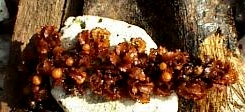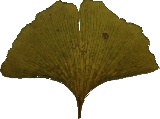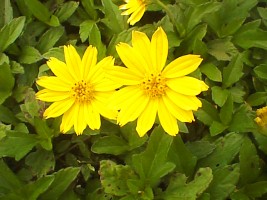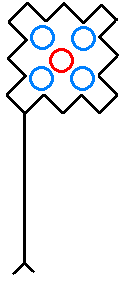Multiple Options
1. A botanist who identifies two plants as being the same species because "they
look alike" is using
- evolutionary species concepts
- morphological species concepts
- genetic species concepts
- biological species concepts
- visiocular species concepts
|
2. Speciation that has occurred on the mountain tops of Pohnpei is most likely due to:
- temporal isolation
- temporary isolation
- mechanical isolation
- gametic isolation
- microhabitat isolation
|
3. In terms of evolutionary survival, a "winner species" is that in which
individuals
- die at the oldest age
- die at the youngest age
- die with the most toys
- die with the most offspring
- die with dignity
|
4. Which of the following is taken as evidence of evolution?
- the cloning of Dolly the sheep
- the development of immunoresistance in AIDS
- the development of retinol to reduce wrinkling of the skin
- the birth of septuplets using fertility drugs
- the presence of cyanobacteria on Pohnpei
|
5. Natural selection presumes that...
- population growth outpaces food production
- population growth equals food production
- population growth lags food production
- population growth is food production
|
6. A new species originates in...
- many places at once.
- a few interconnected places.
- a single isolated place.
- all places at once.
|
7. Morphological plasticity mean that a species...
- displays different growth forms in response to different environmental conditions
- displays a plastic flexibility in its chloroplastic membranes of the organelles
- displays metamorphic capabilities that allow the species to repeatedly change appearance
over short time frames
- displays a pathological preference for plastic compounds in its micorrhizal
associations.
- displays an ability to speciate on a moments notice
- displays might morphin' power ranger capabilities
8. Ferns and lycopodium have lignin which helps the fern or lycopodium:
- reproduce
- withstand polluted air
- perform gas exchanges of CO2, O2,H2O
- stand tall
|
9. Cyanobacteria can contain
- chlorophyll
- a nucleus
- chloroplasts
- mitochondria
|
10. Cyanobacteria get their characteristic color from
- beta caroteins and chlorophyll
- chitin and chlorophyll
- chloroxy and chorophyll
- pizza and pepsi
- phycocyanin and chlorophyll
|
11. The nitrogen fixing nodule in Cyanobacteria is called a
- heterocyst
- highdeehocyst
- holocyst
- homocyst
|
12. In a mycorrhizal association with plantae, fungi typically provide to the plant
roots:
- hydrogen
- nitrogen
- oxygen
- phosphorus
- sugar
- starch
|
13. The phrase "we are immortal in our genes" refers to:
- how good we look in a nice new pair of genes
- life after death
- the continuity of genetic material down through generations
- the importance of our genes to the expression of physical traits
|
14. In terms of evolutionary success, a long life is only beneficial if...
- maximal size is attained by the organism continuing to grow throughout the increased
lifespan
- physical fitness is enhanced by the organism remaining physically healthy throughout the
increased lifespan
- reproduction is enhanced by the organism remaining reproductively viable throughout the
increased lifespan
15. Fungal hyphae...
- create phosphorus
- destroy phosphorus
- immobilize phosphorus
- transport phosphorus
16. If you take a blade of algae and rub it on your face for ten minutes and wind up
with your face covered in slimy mucilage, then you have most likely found a:
- blue-green algae
- brown algae
- green algae
- rainbow coalition algae
- red algae
17. On the beaches of Kosrae there occasionally washes up these masses of small brown
leaves with little yellowish-brown to white balls. This algal material floats on the
surface of the ocean. It is a member of:
- Cycadophyta
- Gingkophyta
- Lycopodophyta
- Phaeophyta
- Pinophyta
|
 |
18. The shown leaf is from:
- Chrysophyta
- Cycadophyta
- Gingkophyta
- Lycopodophyta
- Pinophyta
|
 |
19. How do plants conserve water during dry conditions?
- by moving into the shade
- by closing their stoma
- by forming micorrhizal associations
- by taking in nitrogen
- by releasing oxygen
20. C4 plants avoid a problem that plagues C3 plants, a problem associated with
photosynthesizing during conditions under which the plant must conserve water, what
problem does the C4 mechanism circumvent?
- the build-up of carbon dioxide inside the leaf leading to photosynthesis
- the build-up of oxygen inside the leaf leading to photorespiration
- the build-up of perspiration inside the leaf leading to malodorousness
- the build-up of water inside the leaf leading to hyperhydration
21. At the core of scientific methods is the concept...
- of faithfulness, that the results are beyond question and must be taken on faith
- of falsifiability, that there exists experiments that could disprove a hypothesis
- of ingenuity, that there exists ingeneousness that will drive the method forward
- of morality, that there exists rules for proper human behavior
- of predictability, that there exists a predestined outcome
- of veracity, that the method produces the unassailable truth under all circumstances
22. What is wrong with the statement, "the moon is populated by little green men
who can read our minds and will hide whenever anyone on the Earth looks for them, and will
flee into deep space whenever a spacecraft comes near"?
- it is an underlying tenet of the X-files
- it is not falsifiable
- it is not fashionable
- nothing, it is true
23. "Fixing" nitrogen means
- converting N2 to NH3, NO2, and NO3
- converting NH3 to N2, NO2, and NO3
- converting NO2 to N2, NH3, NO3
- converting NO3 to N2, NH3, NO2
- repairing nitrogen that has been damaged
|
24. Cinnamon comes from:
- secondary xylem
- secondary phloem
- periderm
|
Matching
- ____ Ascomycetes
- ____ Basidiomycetes
- ____Chlorophyta
- ____ Magnoliophyta
- ____ Cyanophyta
- ____ Coniferophyta
- ____ Phaeophyta
- ____ Rhodophyta
- ____ Zygomycetes
|
- Eukaryotic brown algae
- Eukaryotic green algae
- Eukaryotic red algae
- Eukaryotic with elaborate spore containers
- Eukaryotic with naked seeds
- Eukaryotic with peglike spore structures
- Eukaryotic with saclike spore structures
- Eukaryotic with seeds in fruit
- Prokaryotic with phycocyanins
- Prokaryotic with chitinous cell walls
|
- ____ Club and spike mosses
- ____ Ferns
- ____ Mosses with an erect growth habit, main stem is of limited length
- ____ Mosses with a matlike growth habit, main stem is of unlimited length
|
- Acrocarpus
- Lycopodophyta
- Pleurocarpus
- Pteridophyta
|
- ____ Abscissic acid
- ____ Auxin
- ____ Cytokinins
- ____ Ethylene
- ____ Gibberillins
- ____ Phloem
- ____ Xylem
|
- Carries carbohydrates
- Carries water and minerals
- Inhibits growth
- Promotes cell division
- Promotes internode elongation
- Ripens fruit
- Stimulates apical growth
|
- ____ Cinnamomum zeylonica
- ____ Coffea arabica
- ____ Myristica fragrans
- ____ Piper nigrum
- ____ Theobroma cacao
|
- red drupe
- fragrant nut
- former export of Pohnpei
- drink of the gods
- bark food
|
Word(s) or sentence answers
- List the five kingdoms
- What is the function of lignin in the seedless vascular plants?
- What color is the flower of the Cook Island Pine, Araucaria columnaris?
- What is the name for the "big improvement" on spores that the gymnosperms
evolved for moving their sperm cells to their eggs?
- What is the primary mechanism for moving this "big improvement" to the eggs?
- What is a strobili?
- What is so exceptional and special about the Wollemi Pine?
- What is a stolon?
- To which kingdom does penicillin belong?
- What kingdom has chitin in its cell walls?
- Write any one of the local names for cyanobacteria in Micronesia.
- Write any one of the local names for a shelf or bracket fungus in Micronesia.
- Why isn't moss found in downtown Chicago?
- Name two different environments in which we found Chlorophyta during our swamp walk.
- Name one type of plastid.
- Give the function of the plastid you named in number one.
- What is Kava KavaŽ?
- What is the color of the coffee flower?
- What is the color of the cycad flower?
- What are the inputs to photosynthesis?
- What are the outputs from photosynthesis?
- What is rubisco's problem anyway?
- What does an N-P-K rating refer to for fertlizer?
Sentences or Paragraph answers
- Why is chlorophyll green?
- What is the adaptive advantage to red algae being red?
- What is the purpose of phycocyanins in cyanobacteria?
- If you see black bread mold on your bread and cut the mold off the bread...
- ...is the bread mold free?
- Why?
- Based on what was covered in lecture, why would agriculture quarantine officers have to
be concerned about someone importing soil?
- 80% of the atmosphere is nitrogen. Through what mechanism/system/entities do plants
obtain nitrogen?
- What are the primary functions of the leaf cuticle?
- What is the primary function of pallisade mesophyll?
- Draw a labelled diagram of a water molecule identifying the elements and showing the
charge distribution.
- What is the cohesion-tension theory?
- Name the plant whose seed slept for 1200 years.
- What is the function of root hairs?
- Give the latin name, spelled correctly, of the plant seen on the right.

Labeled drawings/sketches
- Draw a typical member of basidiomycetes.
- In the center of the "head" of the shown chlorophyll molecule is a complex of
five atoms comprised of two elements. Correctly label these five atoms in the head of the
chlorophyll

- Make a labelled sketch of a simple flower. Include all four whorls in your diagram,
label each of the parts correctly.




